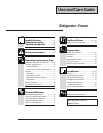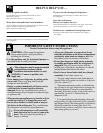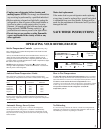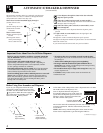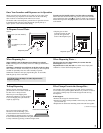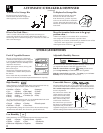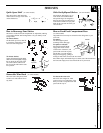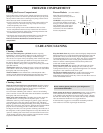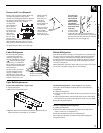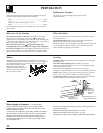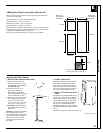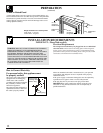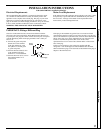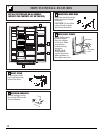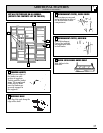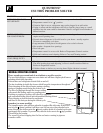
FREEZER COMPARTMENT
Loading the Freezer Compartment Freezer Baskets (on some models)
Load so that at least 15 mm of space remains clear between stacks of
packages and 15 mm to 25 mm of space between the top of any stack
and any shelf or basket above it. Packages may hang over the front of
shelves but must remain 15 mm from doors.
• Food to be frozen must not be placed in direct contact with food in
storage. If food is to be frozen every day, it may be necessary to
reduce the quantity to be frozen.
• Food is most quickly frozen on the middle three shelves of the
freezer compartment and most slowly in the freezer door shelves.
• Do not store commercially quick-frozen food longer than the time
recommended by the food manufacturers.
• The freezer door storage shelves marked with a two-star label are
only appropriate for the storage of previously frozen food.
Effervescent drinks should not be stored in the freezer
compartment.
Wire slide-out freezer baskets
can be pulled out for easy access to
frozen foods.
WARNING: Poor performance may
occur if freezer baskets are not used.
Storage of items in the freezer without
using baskets may result in poor
temperature performance due to
restrictions of air flow within the
freezer compartment.
CARE AND CLEANING
Cleaning—Outside
The water and ice dispenser spill shelf should be wiped dry
immediately to prevent spotting. Water left on the shelf may leave
deposits that you can remove by soaking in undiluted vinegar.
You can also use a paste of non-precipitating water softener and water,
or 5 ml of citric acid powder per 500 ml of hot tap water. Soak until
the deposit disappears or becomes loose enough to rinse away.
Usually 30 minutes soaking time is adequate. Avoid using wax on the
spill shelf and trim.
The dispenser pad can be cleaned by using a warm water and baking
soda solution—about 15 ml of baking soda to one liter of water. Rinse
thoroughly with water and wipe dry.
The door handles can be cleaned with a cloth dampened with a
solution of mild liquid dishwashing detergent and water. Dry with a
soft cloth. Don’t use wax on the door handles with metal trim.
Keep the finish clean. Wipe with a clean cloth lightly dampened with
kitchen appliance wax or mild liquid dishwashing detergent. Dry and
polish with a clean, soft cloth. Do not wipe the refrigerator with a
soiled dishwashing cloth or wet towel. These may leave a residue that
can erode the paint. Do not use scouring pads, powdered cleaners,
bleach or cleaners containing bleach because these products can
scratch and weaken the paint finish.
Protect the paint finish. The outside of the refrigerator has a high
quality, baked-on paint finish. With proper care, it will stay new-
looking and rust-free for years. Apply kitchen/appliance wax when the
refrigerator is new and then at least twice a year.
The long door handles and trim (on models with trim kit) can be
cleaned with a cloth dampened with a solution of mild liquid
dishwashing detergent and water. Dry with a soft cloth. Don’t use wax
on the door handles and trim.
Cleaning—Inside
Inside the fresh food and freezer compartments should be cleaned
at least once a year. Unplug the refrigerator before cleaning. If this is
not practical, wring excess moisture out of sponge or cloth when
cleaning around switches, lights or controls.
Use warm water and baking soda solution—about 15 ml of baking
soda to one liter of water. This both cleans and neutralizes odor. Rinse
thoroughly with water and wipe dry.
Other parts of the refrigerator—including door gaskets, meat and
vegetable drawers, ice storage bin and all plastic parts—can be
cleaned the same way. After cleaning door gaskets, apply a thin layer
of petroleum jelly to the door gaskets at the hinge side. This helps
keep the gaskets from sticking and bending out of shape. If the freezer
baskets don’t slide freely after cleaning, lubricate them with petroleum
jelly. Do not use cleansing powders or other abrasive cleaners.
To help prevent odors, leave an open box of baking soda in the rear of
the refrigerator, on the top shelf. Change the box every three months. An
open box of baking soda in the freezer will absorb stale freezer odors.
Avoid cleaning cold glass shelves with hot water because the extreme
temperature difference may cause them to break.
Drain opening in the freezer compartment. During yearly cleaning,
remove bottom freezer basket and flush a baking soda solution—
5 ml of baking soda and 500 ml of hot (not boiling) water—through
the drain line with the help of a meat baster. This will help eliminate
odor and reduce the likelihood of a clogged drain line.
If drain becomes clogged, use a meat baster and baking-soda-and-
water solution to force the clog through the drain line.
Do not wash any plastic parts from your refrigerator in
your automatic dishwasher.
8



